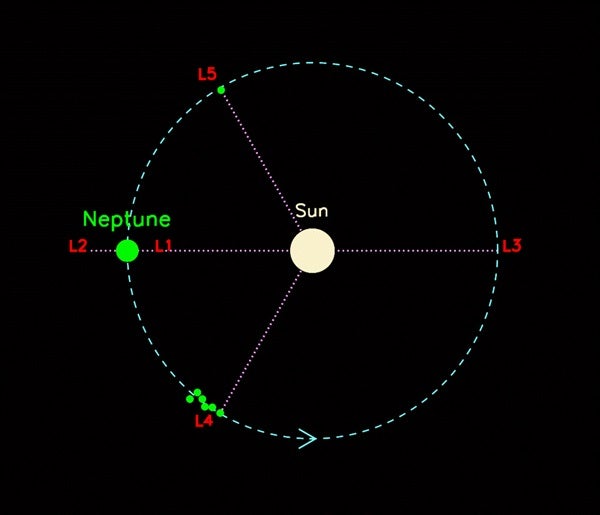Scott Sheppard from the Carnegie Institution in Washington, D.C., and Chad Trujillo from the Gemini Observatory in Hilo, Hawaii, have discovered the first Trojan asteroid, 2008 LC18, at a difficult-to-detect stable spot near Neptune called Lagrangian point L5. In their quest to find out whether Neptune Trojans at L5 exist, they used the 8.2-meter Subaru Telescope’s camera at prime focus (Suprime-Cam) to locate the asteroid and the Carnegie 6.5-meter Magellan Telescope to determine its orbit.
Lagrangian points are five places in space where the gravitational tugs from two relatively massive bodies — the Sun and a planet — balance out, and where smaller bodies like asteroids can remain essentially fixed with respect to the planet. The Lagrangian points L1, L2, and L3 are unstable, so that slight displacement of an object may result in its rapid exit. The other points, L4 and L5, 60° ahead of and behind the planet, are stable, so dust grains and other objects remain in the vicinity and tend to collect there.
Just as the Trojan horse protected the Greeks hiding inside its huge wooden structure, so too are Trojan asteroids found in these relatively protected areas along a planet’s orbit around the Sun. Trojans share their planet’s orbit, but they do not collide with it because they stay safely near the Lagrangian points. Sheppard and Trujillo found three of the six known Neptune Trojans in the L4 region in the past several years, but Neptune’s L5 region is difficult to observe.
Since Neptune Trojans are faint and scattered over large areas of the sky, the astronomers used the Subaru Telescope to search for them. The Subaru Telescope is the only 8-meter-class telescope in the world with the ability to mount an instrument at prime focus. Fitted with the Suprime-Cam, it can survey large regions of the sky and efficiently discover faint objects. The astronomers’ observations showed that at least one Trojan asteroid exist in the L5 region of Neptune.
“We estimate that the new Neptune Trojan has a diameter of about 62 miles (100 kilometers), and that there are about 150 Neptune Trojans of similar size at L5,” said Sheppard. “It matches the population estimates for the L4 Neptune stability regions. This makes Neptune Trojans larger than about 31 miles (50 km) more numerous than those bodies of similar size in the main asteroid belt between Mars and Jupiter. There are fewer Neptune Trojans known simply because they are very faint, since they are so far from the Earth and Sun.”
Sheppard and Trujillo’s research suggests that these stable regions may have captured Neptune Trojans during an early phase of the solar system, when Neptune was moving in a different orbit than it is now. A slow, smooth planetary migration process may account for their location in this area. Or, gravitational attraction may have caught and “frozen” the asteroids into these spots as the giant planets settled into their orbits. The solar system may have been a more chaotic place then, and many objects may have been stirred up into unusual orbits. In any case, Trojans help astronomers understand how the planets formed and how the solar system evolved.










